Kyle Duncan is a 22-year-old right-back playing for the New York Red Bulls in the top division in the United States, Major League Soccer. The young American was recently called up to the U-23 US Men’s National team, which will participate in the upcoming Olympic Games in Tokyo. This selection indicates that the United States national team sees a bright future for the Red Bulls’ full-back.
His journey in the professional game began in France for Valenciennes, a Ligue 2 side. In 2018, the Red Bulls offered him his first MLS contract in his hometown of New York. By 2019, Duncan started 13 matches out of the 34 played that season. This rotation was Chris Armas’s (NYRB manager) way of integrating his young right-back into the squad while still providing him ample game time with the New York Red Bulls II.
This year, Duncan had a strong start to the 2020 MLS season where he registered a goal and an assist against FC Cincinnati. Armas’s tactics made Duncan a focal point of his attack. Despite being a right-back, Duncan pushes incredibly high up the pitch. This is similar to the Liverpool right-back, Trent Alexander Arnold’s, positioning on the pitch. Like Jurgen Klopp, one of the Premier League’s top managers, Armas wants to utilise the ability of his young and skilful right-back.
This scout report and tactical analysis will examine Kyle Duncan’s strengths and weaknesses in the New York Red Bulls side and how he fits into Chris Arnas’s tactics.
Attacking positioning – progressive runs
One of the areas of Duncan’s game that is very strong is his ability and willingness to get into attacking positions. His position is high and wide, uncharacteristic of a right-back, due to Armas’s tactics in the 4-4-2 formation. The winger on the right side would pinch in, allowing Duncan to have more space moving forward. There are two reasons this is effective. While the ball is on the left side, the right-midfielder pinching in can offer more control in the midfield. It can also allow for space to open for Duncan and the opposing left-back needs to decide whether he will pinch in and follow his man or stay in the channel to prevent the switch to Duncan.
In the analysis below, you see an example of this unfolding during the opening match against Cincinnati FC. As mentioned earlier in the scout report, Duncan had a fantastic performance in this match, and this is the beginning of a pattern of play that would lead to his first goal in the 2020 season. Here, the right-midfielder, Florian Valot, pinches in to try and create a numerical advantage for the Red Bulls in a very congested midfield. This creates a difficult decision for the left-back, Greg Garza, who has to decide whether to follow Valot or cover the space that Duncan (pictured on the far right) is poised to take. By drifting into the midfield area, Duncan is allowed more space and has the chance to catch the left-midfielder covering him exposed. This phase of play develops extremely quickly and is masterfully constructed by Armas.
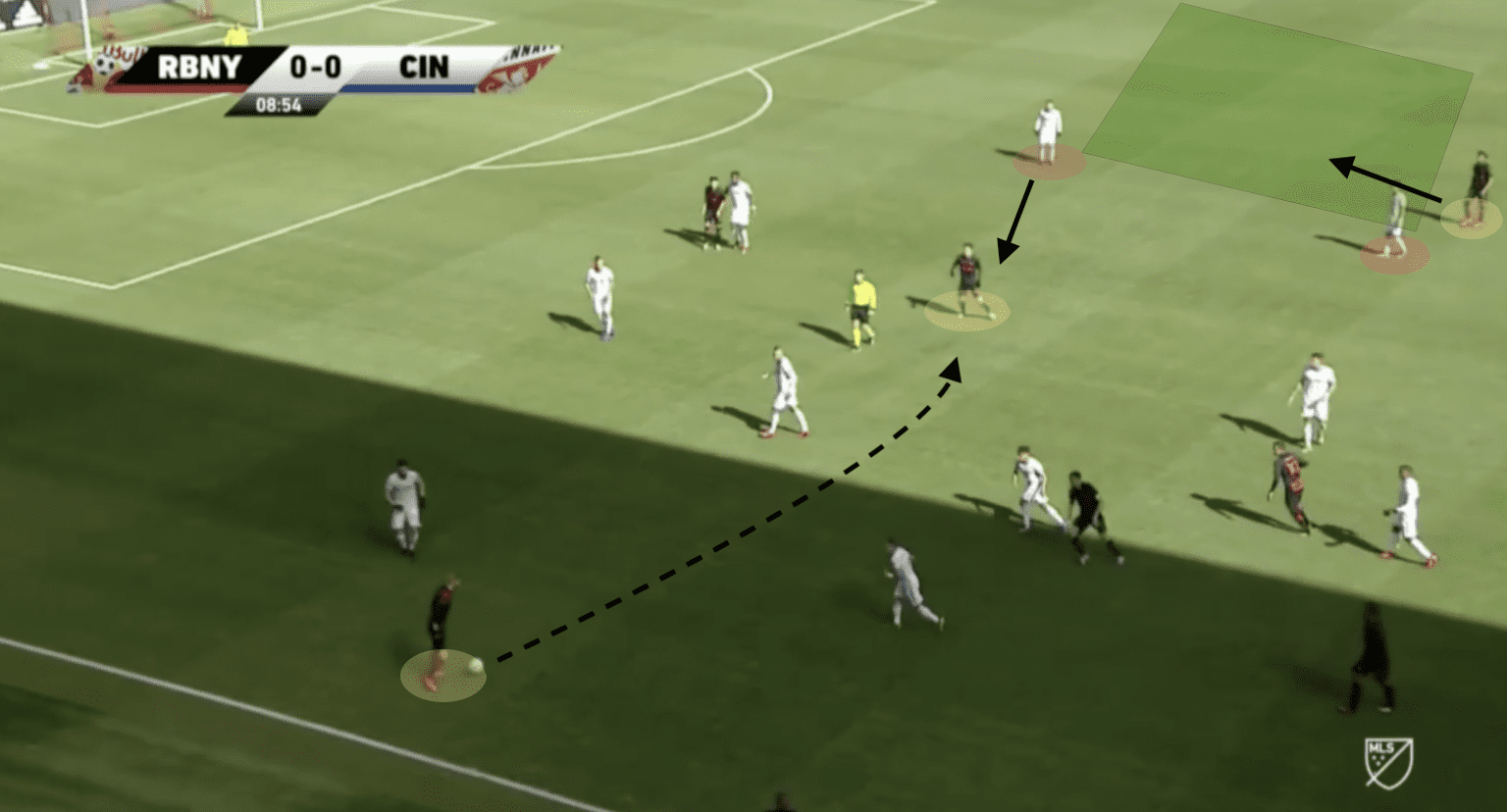
Armas knows that Duncan has pace and energy that will allow him to reach the position needed to join the attack. In the analysis below, Casseres Jr. receives the ball from the left-wing (as seen above). Immediately, he turns to open up and play the ball into the free space on the right-hand channel. Duncan, again who is on the left-winger’s shoulder, bursts into space while leaving the opposing left-winger behind. He is incredibly open and has time on the ball. At this moment, he essentially becomes an auxiliary winger while the Red Bulls are in possession. Duncan created a fantastic chance at goal as a result of the tactics employed by Armas and his awareness space.
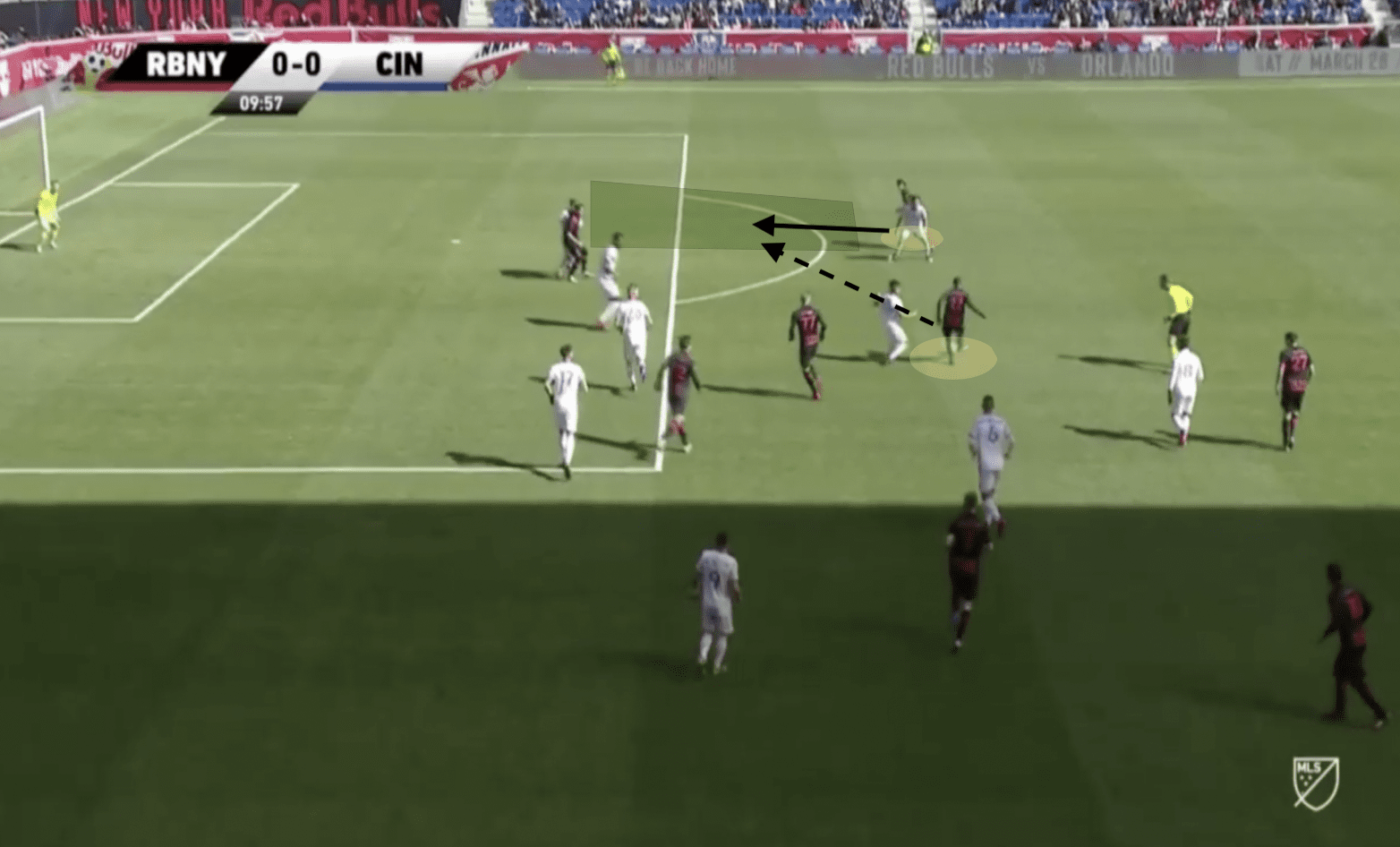
Attacking position – in possession
Duncan’s instructions to get forward and be a part of the attack create many different options and patterns of play for the Red Bulls. As mentioned earlier in the scout report, Duncan constantly goes forward into space. In addition to his progressive runs, while in possession of the ball, Duncan pushes high and is not shy of taking on players and providing different passing options for the midfielders and forwards in the attack.
While in possession in the final third, Duncan ranks fairly high among fellow field players. In the statistics shown below, Duncan is an effective dribbler in the final third. He achieves a 66.7% dribble success rate in the final third, allowing for the Red Bulls to continue to develop the play while attacking. When judging him against fellow outfield players in the MLS (over the past year), Duncan is strong in the category. Despite being a full-back, he currently averages 3.59 dribbles per match, ranking ninth in the entire MLS. He is actively involved in the attack and has become a focal point for the Red Bulls.
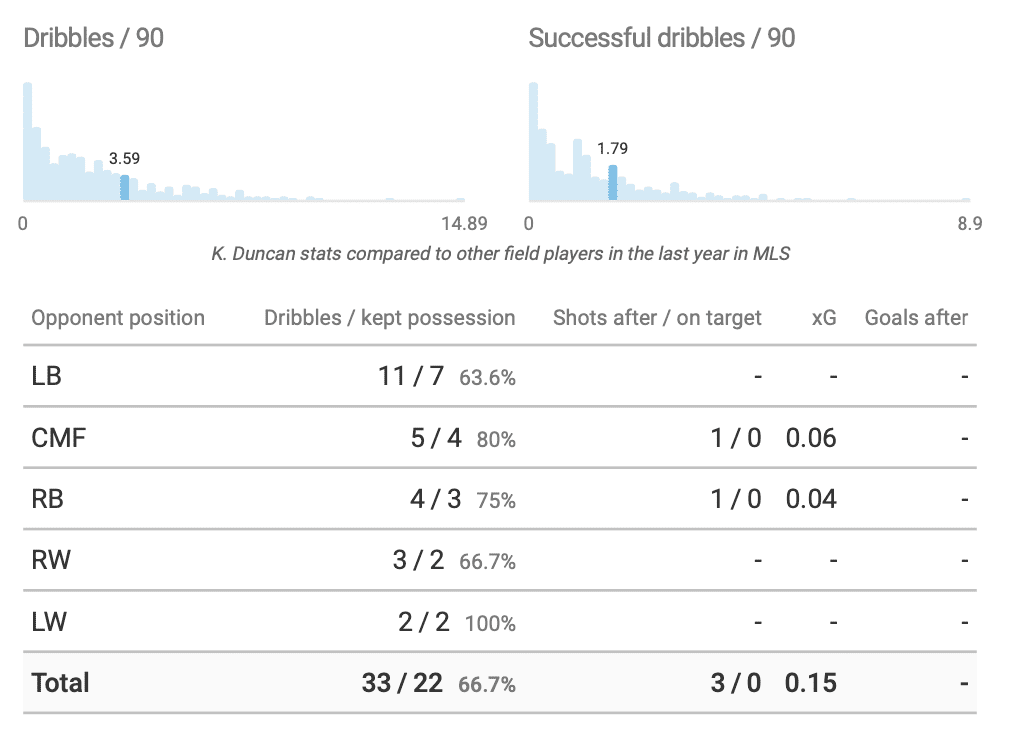
Duncan is clearly a player that gets into promising positions constantly. This is true while off the ball, in possession or in support of his teammates. Some right-backs do not venture forward as much, however, Duncan is constantly available for passes during the build-up play. The reason he can be a part of the build-up is that he is fast, aggressive and consistent in possession. If he ever loses the ball, he can immediately get involved in the counterpress, which will be discussed later in the scout report and tactical analysis.
The analysis below provides an example of how Duncan constantly provides an option for the player in possession. His positioning creates triangles and certain patterns for the Red Bulls to develop dynamic attacking football. Duncan will play the ball and make overlapping runs. As seen in this example, he becomes a lateral option for Valot, who is under immense pressure from an FC Cincinnati counterpress. These progressive positionings further cement the claim that Duncan is an extremely versatile and attacking full-back. His understanding of his position and ability to get into favourable areas for his teammates to pass him the ball are major strengths.
In this sequence, Duncan and Valot play a tidy combination, creating a triangle “one-two” progression. Duncan is then allowed to continue dribbling into the space past the FC Cincinnati defenders.
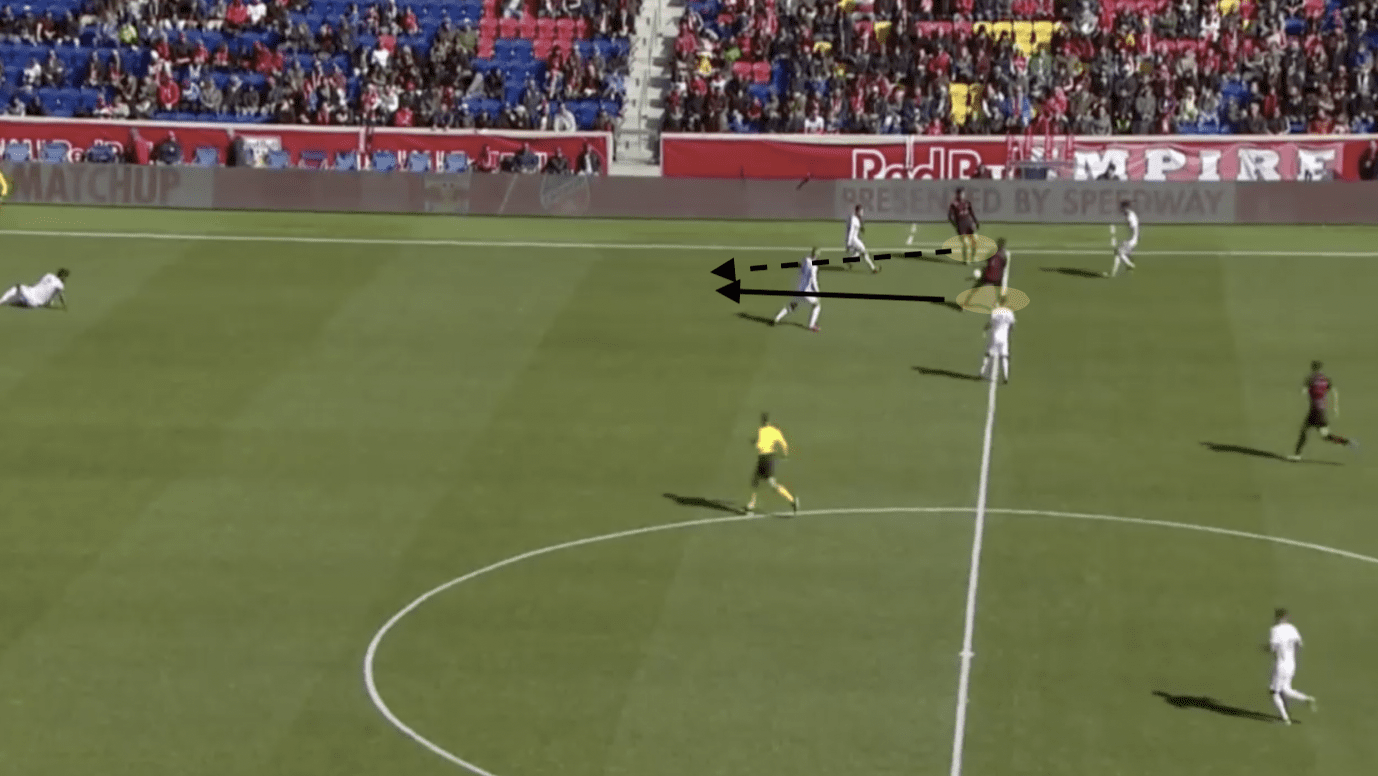
Counterpressing
Duncan’s high position on the pitch allows him to affect the game defensively as well. Every manager strives for utmost consistency while in possession, however, there will always be moments when a player will lose the ball. In these moments, the “gegenpress” or counterpress becomes incredibly important if a manager decides to utilise that tactic. The counterpress occurs the instant the team in possession loses the ball and immediately pressure to try and win the ball back. Armas employs this tactic for his Red Bull side who are very intent on pressing without the ball and utilising the counterpress when in the defensive transition.
Duncan is a perfect example of a player who is well equipped to be a part of the counterpress, and his statistics prove this claim. Duncan is sound defensively and has the ability to put immense pressure on the ball if it is lost. Furthermore, his close positioning in the build-up play, as shown earlier in the scout report, ensures he’s not far away from the ball. Of all the recoveries Duncan made in the past year, he ranks in the top percentile against other players. Duncan had 5.29 average counter-press recoveries per 90 minutes, while the highest amount was 7.3. However, as you can see from the graph, a large percentile of the players rank below Duncan in this category.

Duncan completed 111 counter presses with almost half of them (44) occurring in the central third of the pitch. This shows how Duncan can be effective in both the attacking and defensive areas of the game while in an advanced position. Because his average position is just behind the halfway line, and commonly even with the deep-lying centre-midfielder, Casseras Jr., his positioning leads to him being very involved defensively.
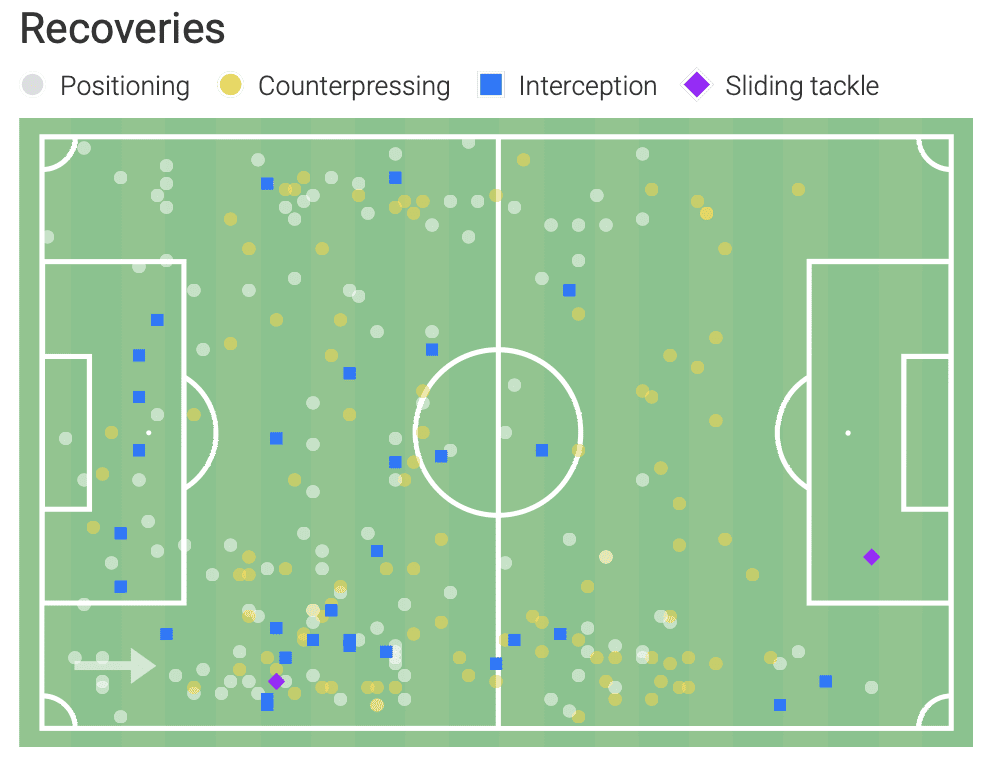
As seen above, Duncan is incredibly active throughout the 90 minutes while in the recovery phase of play. Most of his activity occurs because of his positioning. The American does not utilise the slide tackle as much as a traditional full-back, however, he utilises the standing tackle constantly. He averages 10.37 defensive duels per 90 thus far in the 2020 MLS season, which is combined with a 68.18% success rate. Duncan ranks eleventh in the MLS in this statistic.
Danger in behind
In this scout report thus far, Duncan’s positioning has been a point of emphasis. With the ball, without the ball, or when involved in the defensive transitions, Duncan thrives due to his positioning. His willingness to get forward coupled with Armas’s tactical instructions create a dangerous weapon for the Red Bulls.
However, there are times when his positioning comes back to haunt him. This is an expected tradeoff due to his advanced nature. Where Duncan can get better is managing and reading certain situations. Deciding when to push forward into the final third is important, especially for an attacking full-back. If they commit too far forward, it is common that pockets of space will open up behind them. Again, this is likely expected by Armas, but Duncan’s decision making needs to be correct in order to be effective. The right-back does get forward often, but he is not a winger on the team sheet and has defensive responsibilities too. This claim may be counterintuitive because of the counter-press piece of this scout report, but the emphasis here in this section is his decision making.
The analysis below shows an example of when Duncan commits too far forward and pays the price for it. The result of this action was an FC Cincinnati goal, which allowed them to climb back into the match (the score went to 2-1). Duncan becomes far too involved in the build-up play and even drifts into the midfield (Duncan circled below). He is far beyond the midfielder’s average positioning, leaving areas open for a counterattack if FC Cincinnati were to win the ball.
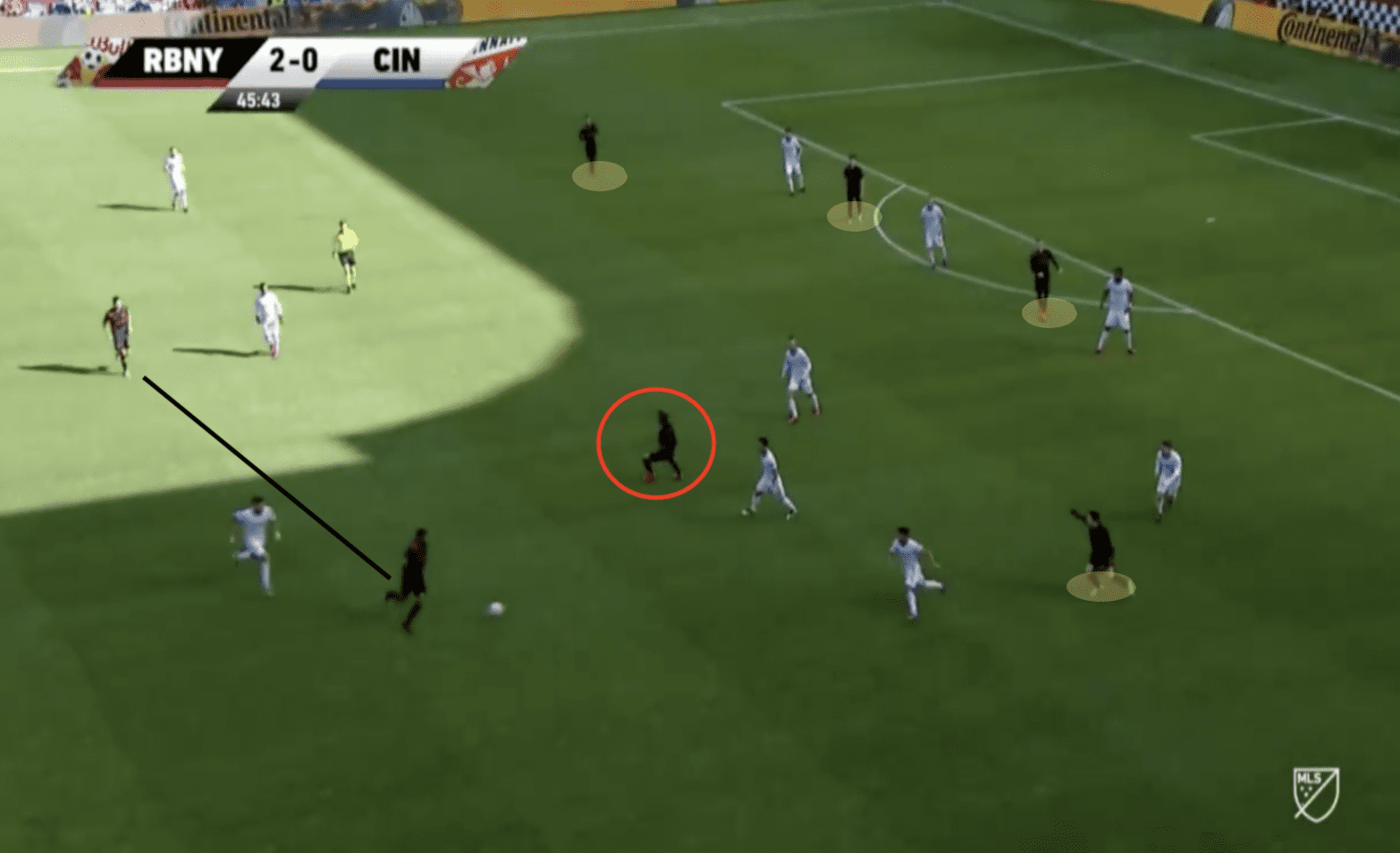
In this case, the opposing side does win the ball, which causes major problems for Duncan. He finds himself extremely out of position, and, because he is in the space between the forward and midfield line, he is unable to counterpress. The young American is caught out and attempts to scramble back into position but it is too late in this phase of the defensive transition, which allows the through ball to be played into Brandon Vazquez, the lone striker for FC Cincinnati.
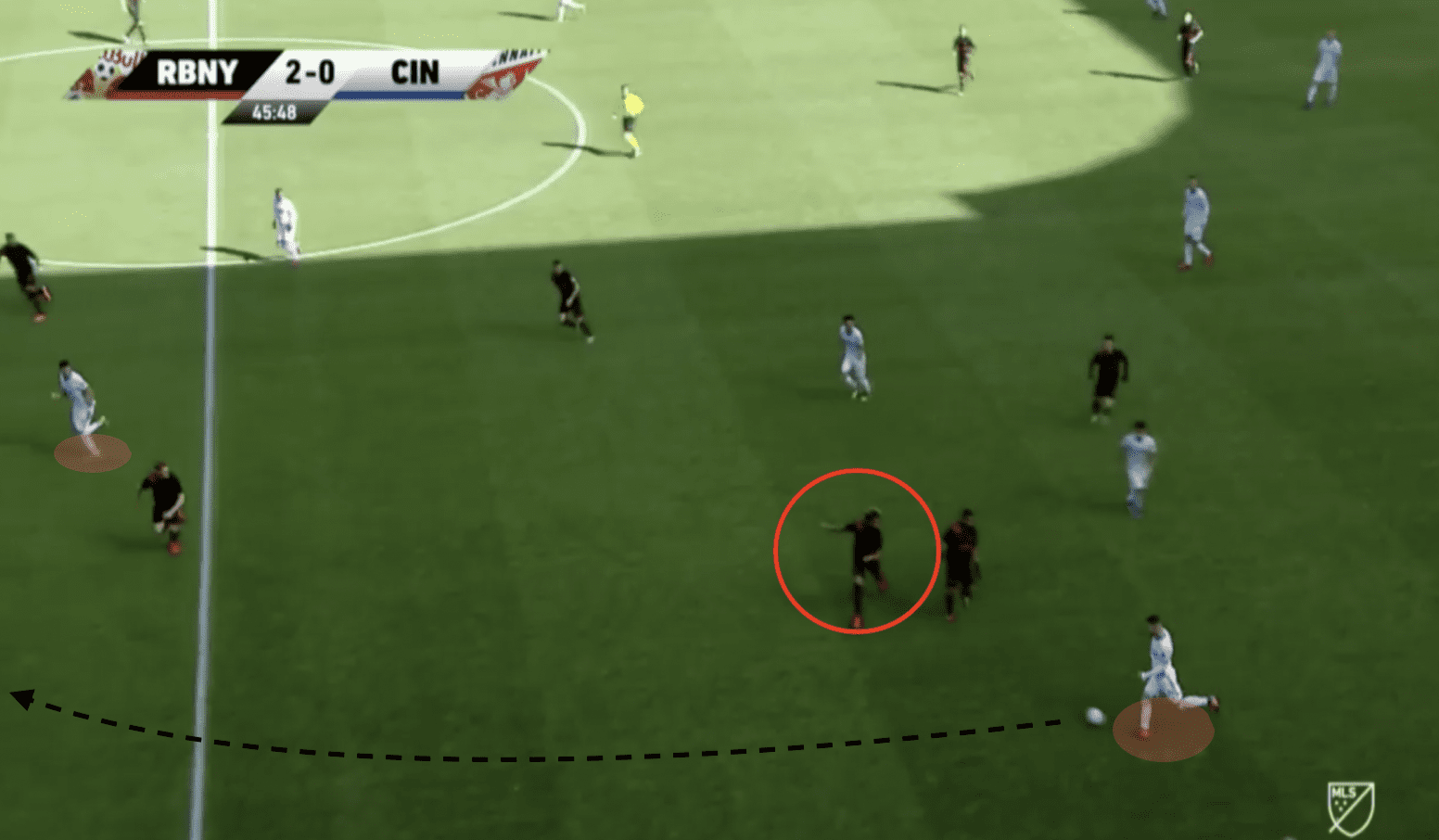
This through ball goes into a dangerous space on the pitch, one that Vazquez capitalises on by driving towards goal, ultimately providing an assist to midfielder Allan Cruz. This area of the pitch is the right-back’s responsibility—one that Duncan abandoned when going forward. Again, this action resulted in a goal for FC Cincinnati.
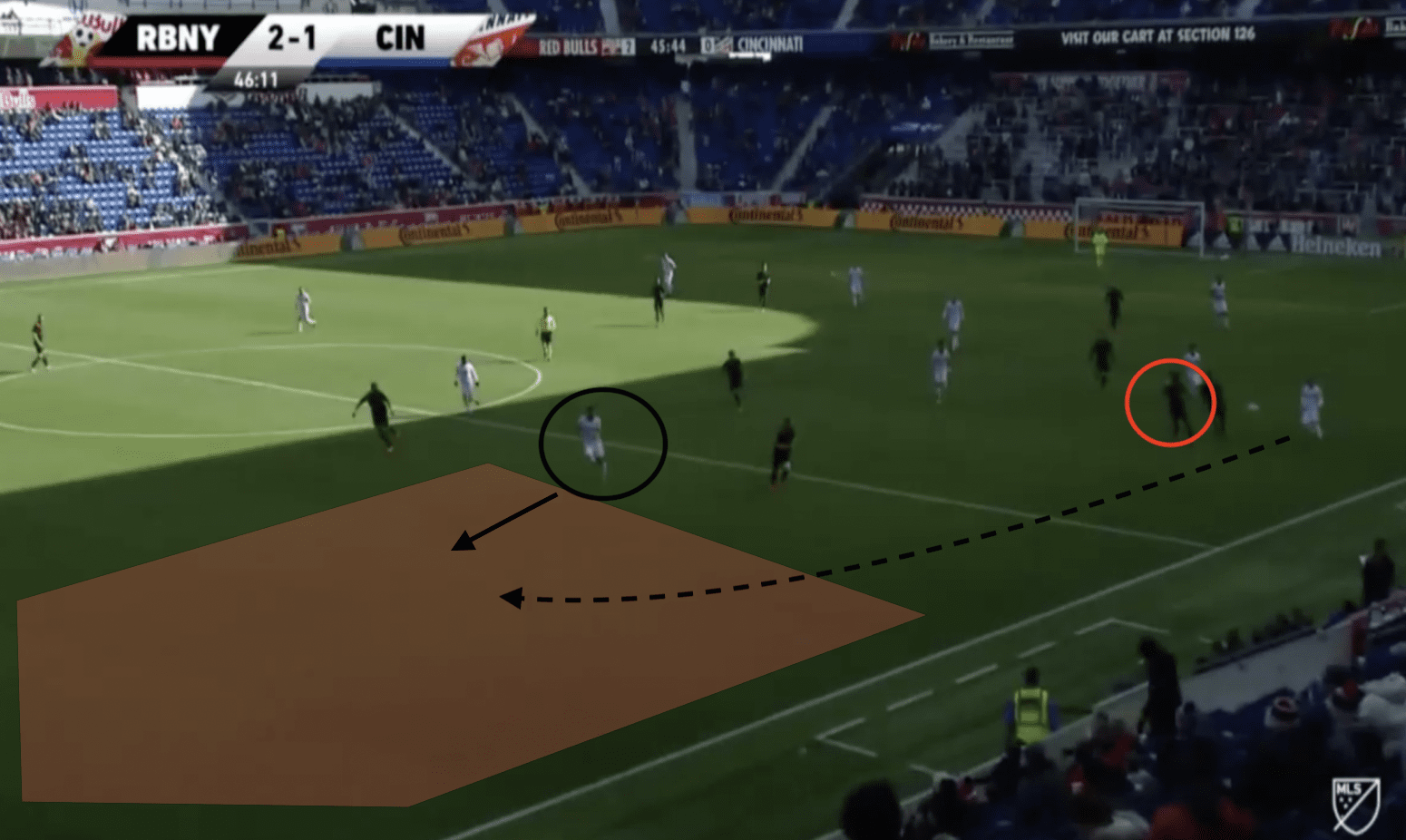
While this is not to suggest that Duncan should never go forward, it highlights a tendency in his game that can sometimes get him into trouble. As he continues to develop, Duncan will have to get more effective at knowing when it is the right time to push forward.
Defensive Capabilities
Finally, a part of any defender’s gameplay that must be analyzed is his defensive attributes. To look at this, data from the previous year’s matches was used. While Duncan has fantastic attacking attributes, defensively he has much room for improvement. He does not stand out in the same light defensively. The young American relies heavily on his pace and stamina to become a presence in the defensive third.
In terms of defensive duels, Duncan won 60.98% of his tackles in the past year. As seen in the graph below, Duncan fails to stand out in this aspect of the game. Despite falling in the middle of the curve, Duncan falls on the right side of the defensive duels per 90-minute curve. He faces 11.03 defensive duels per match, making that statistic one of the highest in the league. Despite being perhaps targeted by other teams (because they can get in behind easier due to Duncan’s high positioning), he does fairly well.

It is important to analyze not just the defensive duels Duncan wins, but also the ones he loses. Unfortunately, the life of a defender is under the microscope of managers who know how important it is to be consistent. While midfielders, and especially forwards, do not get punished as harshly for their defensive lapses, a defender is the last line of defence before the goalkeeper.
Duncan’s statistics lean towards the higher side of danger. He averaged 2.51 lost duels per 90 minutes and 0.54 “dangerous losses” per 90 minutes last season. Dangerous losses refers to a lost duel that leads to a shot or goal. He had a total of 32 lost duels, with two of those leading to goals. This leads to the claim that Duncan is an average defender in the MLS.
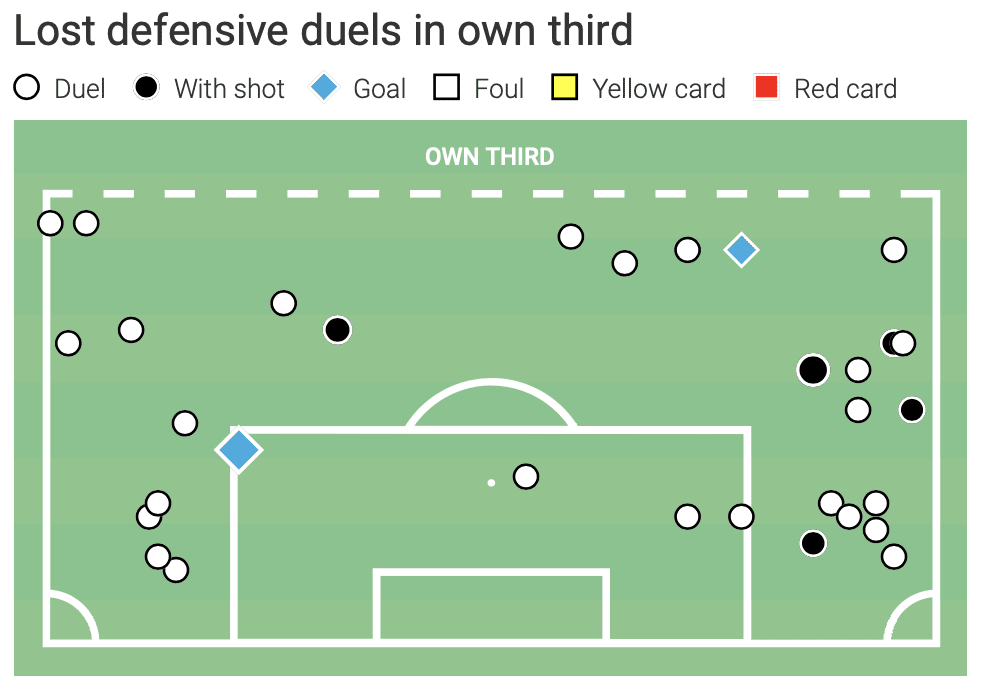
Another part of Duncan’s defensive capabilities that fail to stand out compared to the rest of the league is his aerial ability. Duncan only won 48% of aerial duels during the last season in the MLS. This percentage is very average compared to the rest of the league and one that needs improvement. Other teams can target this weakness considerably.

Defensive duels are very situational, however, aerial matchups are typically very similar. Because of Duncan’s lack of strength and considerable height, it makes him less likely to win headers. Outside backs are not known for their ability to win the ball in the air, but it will be important for Duncan to improve if he wants to stand out defensively.
Conclusion
Overall, Kyle Duncan is a very promising talent. Ducan’s strengths, as outlined in this scout report, are his positioning in the attack and his ability to counterpress effectively. On the other hand, Duncan’s weaknesses are his defensive capabilities when the other team is building up play while in possession.
In order for Chris Armas and the national team to get the most out of Duncan, it is important to tailor the team to fit his attacking strengths. If a team is setting up a low block or are focusing on counterattacking opportunities, Duncan may not be the right player to be in the starting eleven. If Duncan wants to reach the next level and fulfil his potential, he needs to focus on the defensive side of his game. Putting on more muscle to contend for aerial duels as well as improving defensively will lead to him reaching that potential. Being only 22 years of age, Duncan has plenty of time to evolve into a fantastic player for the New York Red Bulls.

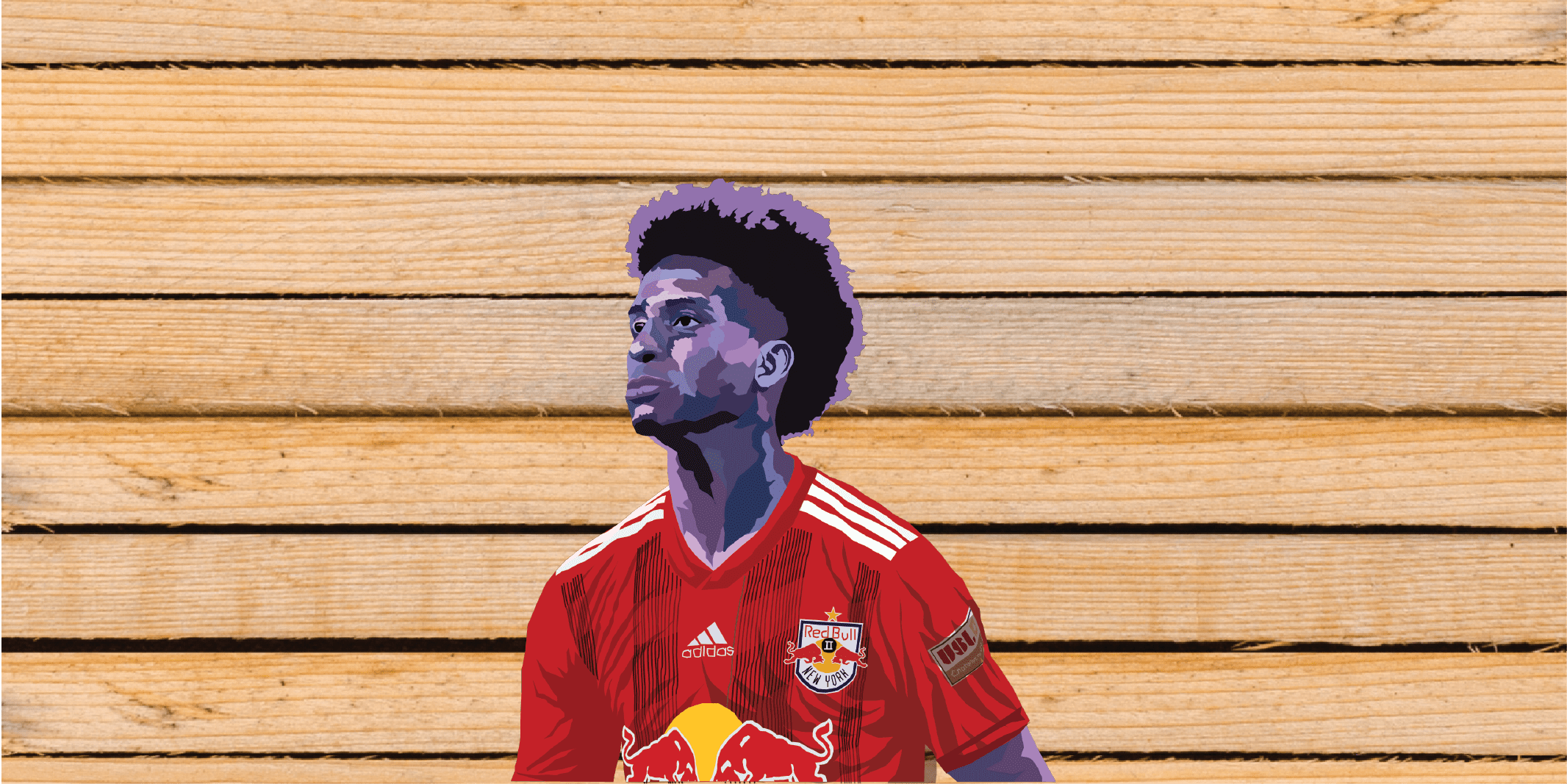



Comments